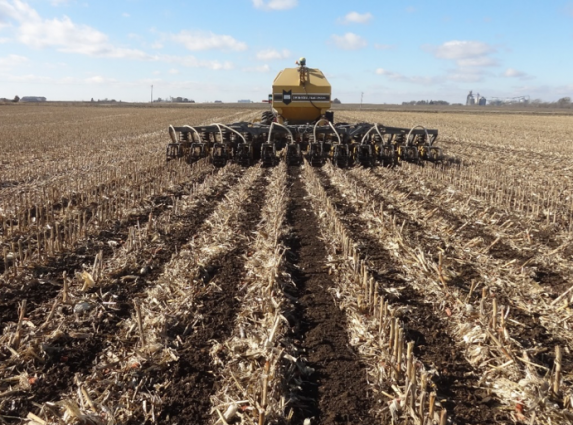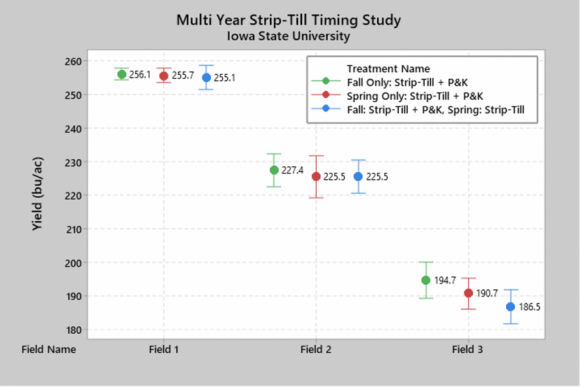Whether you are thinking about trying strip-till or already using strip-till in your farming operation, the question of timing comes up: fall or spring? There are many factors that go into this decision, including availability of equipment and labor, and weather and field conditions that change year to year. This question of fall or spring strip-tillage was the primary focus of a three-year study conducted from 2016 to 2018 at Iowa State University.
A commercial scale test was repeated each year on a minimum of 50 acres in a selected test field. The field site was rotated each year to incorporate varying production conditions into the test. All three fields were in a corn-on-corn rotation. The goal of this trial was to study the impact of varying strip-till timings and nutrient applications.
Three treatments were replicated across each field in side-by-side strip trials to minimize the effects of spatial variability within the fields:
- Fall only strip-till with phosphorous and potassium (P&K) nutrient application.
- Spring only strip-till with P&K nutrient application.
- Fall and spring strip-till passes with the P&K nutrients applied on the fall pass.
A coulter type strip-till machine was used for these studies (Figure 1). It used wavy coulter blades to till a 10-inch-wide zone, while incorporating dry fertilizer product evenly throughout the depth of the zone. This machine was set for 30-inch rows, and the zones were shifted 15 inches each season to be centered between the standing stocks from the previous season. The replacement rate of P&K was calculated for each field depending on crop removal from the previous year and target soil build levels. Monoammonium phosphate (MAP) and potash were used as the source of applied P&K for all fields.

Figure 1: Fall strip-till pass with a coulter style row unit. MAP and potash were applied and incorporated during the tillage pass.
While there were yield differences between the three test fields based on their inherent soil productivity and seasonal weather differences, there were no statistical differences between treatments within the same field (Figure 2). This provides growers with flexibility in the best timing for strip-till in their operation based on available labor and equipment. It also allows them to be flexible with the timing of strip-till year-to-year as weather and other operational factors change. If the fall season is late and wet or there is an early freeze, there is still an opportunity to do strip-till and nutrient application in the spring without substantial yield penalties.

Figure 2: Yield results of the multi-year strip-till timing study conducted at Iowa State University. This data shows no statistical difference between treatments within the same field, indicating that timing of strip-till and nutrient application can vary as needed to fit a given operation or crop year.
The flexibility of strip-till and nutrient application is key to making this system successful in any grower’s operation. It allows the grower to fit strip-till into their operation as it works best for them and change it year to year depending on weather and other operational factors.
Credit:
Authors: Levi Powell, Matt Darr and Ryan Bergman
Integrated Crop Management News
Iowa State University Extension and Outreach
Learn More
Strip-Till Farmer's Building Healthier Soil and Profits with Strip-Till series is brought to you by Environmental Tillage Systems.
At Environmental Tillage Systems, we believe farmers shouldn’t have to choose between doing what’s right for your soil and what’s right for your business. The SoilWarrior is a complete precision zone tillage system custom built for your farm and delivered to you ready to get in the field. Backed by 24-hour service and support, The SoilWarrior takes the guess work out of strip-till so you can concentrate on defending the land and leading the charge. See soilwarrior.com for more information.
21 Strip-Till Fertility Tips for Feeding Plants the Right Diet
Split nitrogen applications, determining the proper placement depth and doing below-ground root assessments are all part of a well-rounded fertility program.






